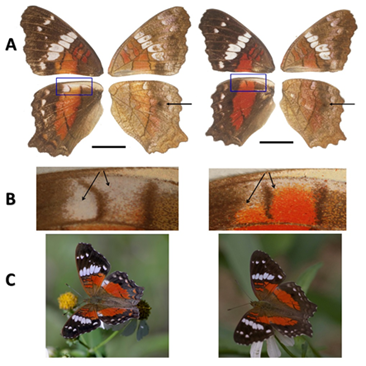Contact: +91-9711224068

FAUNA
- Printed Journal
- Indexed Journal
- Refereed Journal
- Peer Reviewed Journal
Impact Factor: RJIF 5.53
e-ISSN : 2347-2677, p-ISSN : 2394-0522

International Journal of Fauna and Biological Studies
2015, Vol. 2 Issue 1, Part A
Quantifying wing pattern sexual dimorphism in the butterfly Anartia amathea roeselia Eschscholtz (Lepidoptera: Nymphalidae)
Author(s):
Ronaldo Bastos Francini, Thadeu Sobral Souza, Renato Rogner Ramos, Maria Sylvia Cerávolo
Abstract:
The present study searched for morphological markers in the wings ofAnartia amathea roeselia butterfly. This species can be used as a model species due to its natural abundance in SE Brazil and Neotropics. It is an excellent tool for analysis of phenotypical traits and in studies of population genetics. In this research, wing pattern of both sexes were described and quantified in a sample of 812 butterflies considering sexual dimorphism related to size and colour. The results revealed that approximately 55% of the marker spots on the dorsal surface of wings presented little (< 2.5%) or no variation. Therefore, only ten of 22 spots were used as markers in the analysis, with some spots being sexually dimorphic. The female size was bigger than males as well as other Nymphalidae species. The results showed that the colour wing pattern of A. a. roeselia had enough differences to separate individuals of both sexes and morphological markers that can be used to study the role of natural selection upon populations of this species.

Fig. 1: Anartia amathea roeselia. Basic colour pattern of wings. (A) Dorsal (left) and ventral (right) surfaces of female and male. Ventral surfaces are more pallid and present a cryptic pattern. Black arrow indicates the black hindwing spot, which is more visible on the ventral hindwing surface. Blue rectangle delimits sex dimorphic area. Scale bar = 10 mm. (B) Detail of sex dimorphic area where female has a white spot (spot 18; see Figure 3) and male red scales. (C) Actual landing behaviour of active female and male exposing the dimorphic area.
Pages: 43-52 | 2212 Views 507 Downloads

How to cite this article:
Ronaldo Bastos Francini, Thadeu Sobral Souza, Renato Rogner Ramos, Maria Sylvia Cerávolo. Quantifying wing pattern sexual dimorphism in the butterfly Anartia amathea roeselia Eschscholtz (Lepidoptera: Nymphalidae). Int. J. Fauna Biol. Stud. 2015;2(1):43-52.
Important Publications Links
Related Journal Subscription
Allied Journals
Copyright © 2013 - 2024. All Rights Reserved. International Journal of Fauna and Biological Studies




